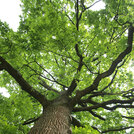
Tree species differ in their ability to reduce air and surface temperatures and increase relative humidity. Trees with a high leaf-area density and rate of transpiration are more effective at cooling air temperatures. This Dresden study found that Corylus colurna (Turkish hazel) and Tilia cordata (Little-leaf linden) had the highest cooling potential and Ulmus x hollandica (Dutch elm) had the lowest.
Gillner, Sten, Juliane Vogt, Andreas Tharang, Sebastian Dettmann, and Andreas Roloff. (2015). Role of street trees in mitigating effects of heat and drought at highly sealed urban sites. Landscape and Urban Planning, 143, 33-42.
